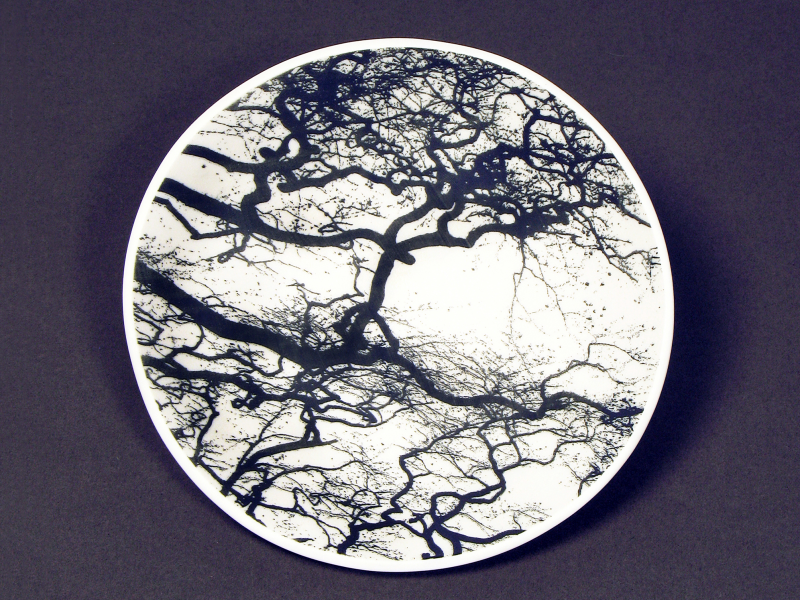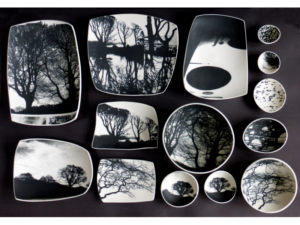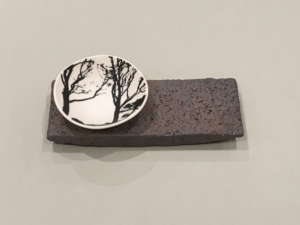Wednesday 12 Feb 2020, 7:45pm at Polehampton Junior School
Ruth Gibson (12 Feb 2020)
Notes
Ruth uses the process of screen printing to produce porcelain bowls, jewellery and fine art work to be displayed at shows, exhibitions, open studios and galleries.
Ruth is a professional artist and is able to employ studio assistants to help produce large volumes of ceramic work. During her interesting talk Ruth discussed how her inspirations and how her work had evolved over the last 20 years. She explained that she has always had a love of photography especially that of black and white photography.
Ruth was originally involved in art and craft making and selling greetings cards. She decided to return to university as a mature student to study ceramics and sculpture at Wolverhampton.
Vikki Shaw was the tutor who introduced Ruth to the process of screen printing directly onto clay. Gwen Healey was another tutor who specialised in clay brick sculptures.
Ruth moved and established her own ‘garden studio’ in 2007.
Ruth’s degree show showcased both disciplines and this laid the base for her future work to develop. She has been involved in various projects including a community project building carved brick bus shelters and a contemporary project she called “shadows of Wedgewood”.
Ruth went on to produce bowls using various sizes of hump mould. She uses Valentine PF700 porcelain clay, white Stoneware clay, paper clay and screen prints using black underglaze directly onto the clay.
Her designs include photographic work featuring birds in a ‘murmuration’, trees and sections of Ordinance Survey Maps “to root them to place.”
Her work goes from small jewellery pieces and tiny bowls glued onto MDF board as an art piece to large images ‘sliced’ and mounted onto board, and large bowls with textured bottoms stained with oxides. (She showed us her process during her demonstration).
Ruth recently was ‘artist in residence’ on the Llyn Peninsula at the Plas Glyn y Weddw. In preparation she made 90 pieces over four months. It took a month to put it together. This exhibition was inspired by the beautiful local scenery. While she was there Ruth made press moulds by pushing clay into tree bark seaweed and ancient groynes on the nearby beach. She made some site specific work and used some clay she found on the beach which she used as slip/glaze.
Demonstration
Ruth demonstrated her screen printed textured porcelain and porcelain paper clay bowl. In her studio Ruth uses a slab roller for convenience. She makes her paper clay using waste porcelain made into sieved slip and 1/3 (approx.) paper (loo roll) added.
Ruth used a large screen print on a frame. The image is printed onto 55 mesh screen. This mesh is ideal for underglaze. For slip Ruth would use a larger 25 mesh screen. The screens are printed for her at her local college.
Clay was rolled out to the required thickness. The surface should be dry enough not to display a sheen. The rest of the slab should be still flexible so Ruth used a hairdryer to speed up the process.
The screen was placed over the slab but not touching. It must be able to ‘spring back’ to ensure a good image is reproduced. Ruth mixed black underglaze powder with ‘ceramic printing medium’. She used masking tape to mask any part of the image not required on the bowl. She used a special tool to spread the underglaze over the image and cleaned all her equipment thoroughly before turning her attention to the clay. The hump mould was inverted onto the clay (image side up) and using the cloth under the clay the whole lot was inverted so that the clay covered the mould. Ruth used a rib to smooth the bowl on the mould. After drying somewhat this was then carefully trimmed then the outside scored and slipped in order to add the textured paper clay. The rolled out paper clay was thrown in torn segments against a plaster batt to distress it and make it ‘wrinkle’. Ruth then used various items such as wood and shells in order to press it onto the clay and produce a textured bottom.
Once bisque fired Ruth will use various oxides in shades of black, brown and blue to highlight the texture. Small amounts of ‘Mayco’ glazes will be added to the inside of the bowl to represent underground rocks and strata; it will then be fired up to 1255 c.
A very interesting and entertaining talk; thank you Ruth!
Mandy Dodd.
for further information please see Ruth’s website:


